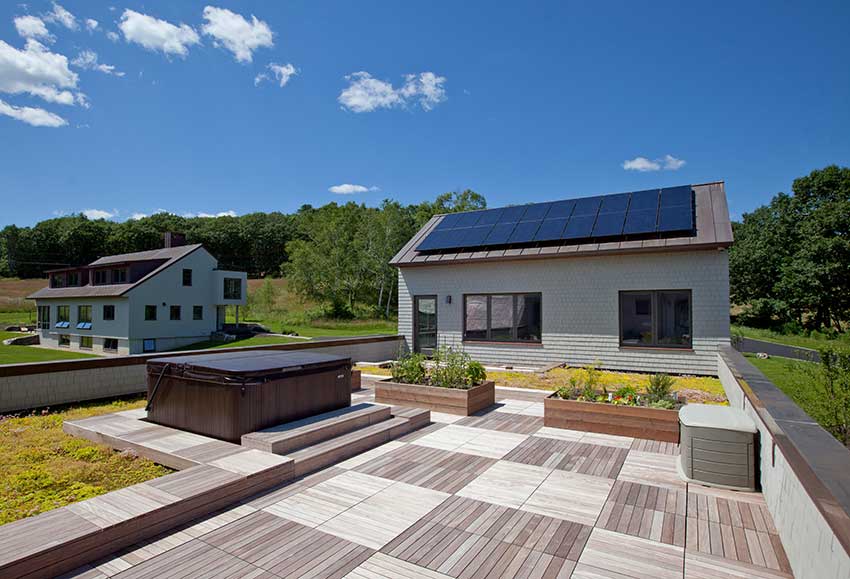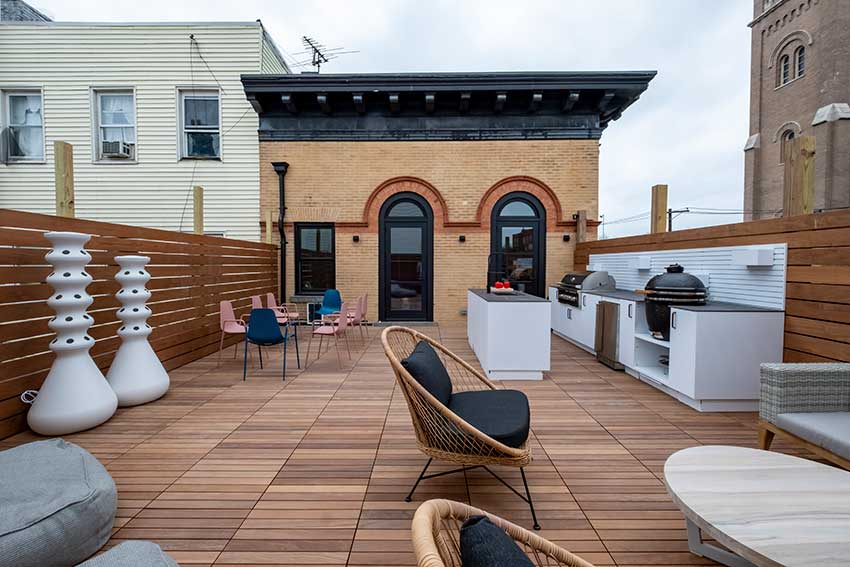Having It All
Creating a circular economy in residential construction
![]() Continuing Education
Continuing Education
Use the following learning objectives to focus your study while reading this month’s Continuing Education article.
Learning Objectives - After reading this article, you will be able to:
- Explain how the new frontier of circular economy in construction impacts sustainability and material use, and select products that have adopted this model.
- Justify why propane is both an ideal and renewable energy source, as well as demonstrate how this fuel contributes to net-zero energy homes and qualifications under LEED for Homes (LEED H v4) and the 2015 National Green Building Standard (NGBS).
- Select doors and movable wall systems that embrace reusability, in both glass and frame, and contribute to a closed material loop.
- Specify decking products that satisfy sustainability and design goals while meeting strenuous material certifications, including LEED v4.1.
Construction and demolition materials are recognized as one of the largest components of the solid waste stream in the US, according to a study at the University of Florida by The Department of Environmental Engineering Sciences, Engineering School of Sustainable Infrastructure and Environment.1 The construction industry is responsible for over 30% of the extraction of natural resources, as well as 25% of all solid waste generated in the world.2 This consumption of materials and production of waste from the building sector is due to a linear economic model that takes, makes, and then disposes of materials at the end of their life or service. The governing assumption under a traditional, linear view is that products and materials assembled for a one-time use don’t retain any potential for reuse.

Photo courtesy of CRL
In addition to being sustainable, products and materials that are recycled or reusable can also improve the health, welfare, and safety of families in residential settings.
However, a paradigm shift is occurring in the construction industry at large with the adoption of a Circular Economy (CE) model.3 Under a CE, materials are seen as existing within a closed loop and have a retained value. CE, as a model of economic development, promotes the maximum reuse or recycling of materials, goods, and components in order to decrease waste generation to the largest possible extent.4 Besides reducing waste and easing consumption, taking a circular view of construction materials and products ambitiously aims to innovate the entire chain of production, consumption, distribution, and recovery of materials and energy. The awareness of increasing constraints on the availability of resources, as well as the increasing demand for access to welfare and well-being, are the foundation of a circular view. These constraints make it evident that there is a need for new economic models capable of improving the efficiency and effectiveness of resource use.5
At home, applying the principles of a CE helps to close the loop on material waste, preserves natural resources, and works seamlessly to address a project’s sustainability goals. Often, using products and materials that are recycled or reusable also improves the health, welfare, and safety of families in residential settings. Products that embrace CE are available in multiple categories, including in exteriors, fenestration, and even in the energy that powers a home. They represent truly having it all.
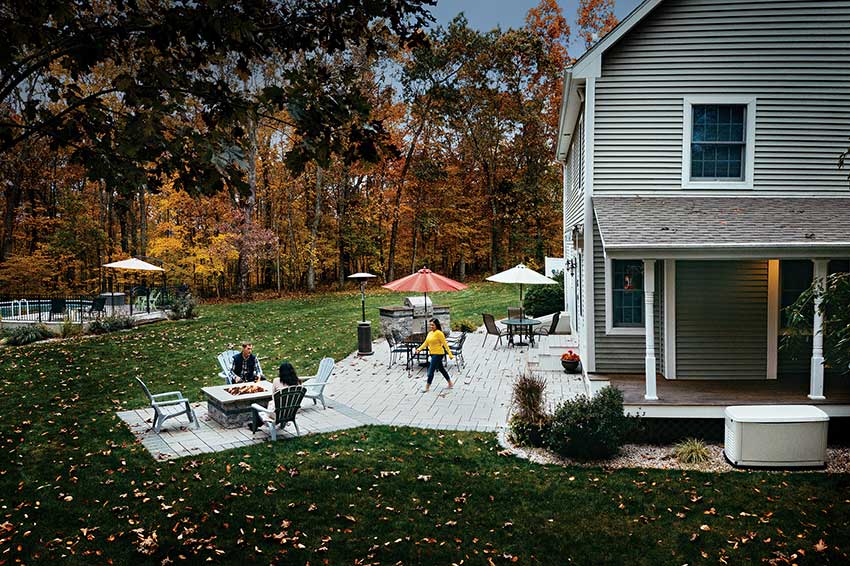
Photo courtesy of PERC
The decarbonization of homes will require more energy options. Propane is an approved clean alternative fuel under the Clean Air Act of 1990.

Photo courtesy of PERC
Renewable propane is made by converting plant and vegetable oils, waste greases, and animal fat into fuel, creating a truly circular energy source.
Powering Homes In A More Adaptable, Efficient Way: Propane
The circular economy (CE) concepts of reduction, reuse, and recyclability of materials and components have successfully been implemented in diverse fields, from electrical equipment and furniture to textiles. However, CE application in the building sphere at large has a shorter history and is often limited to waste prevention and material management.6 The construction sector has a great potential to implement CE strategies, particularly through the adoption of eco-friendly products and technologies.7
A material that can achieve high performance targets and yet meet the most demanding environmental standards, including enabling a home to meet net-zero energy construction, is certainly a material worth considering in a sustainable home’s portfolio. Uniquely, this is also a material that can fuel and power a home – propane.
Propane is an ideal energy source for heating, tankless water heating, cooking, clothes drying, fireplaces, power generation, and more. Propane is a straight-chain alkane, with the carbon atoms structured C-C-C. In terms of individual carbon atoms, propane can be expressed as CH3CH2CH3 or C3H8. When combusted, C3H8 transforms into 3CO2 and 4H2O. Propane is not mined like battery materials or extracted like oil. It is primarily manufactured from natural gas as a by-product of methane purification. Propane’s low carbon intensity is why it is an approved clean alternative fuel under the Clean Air Act of 1990. Propane is methane-free, as opposed to natural gas. Over a 20-year period, one ton of methane has a global warming potential that is 84 to 87 times more than CO2 alone.8 Because it vaporizes when exposed to air, propane does not harm soil and has negligible effects on the ozone. Similarly, propane poses no hazard to drinking water or marine ecosystems. Propane only ignites when in the presence of a specific air mixture and an ignition source above 920 degrees Fahrenheit, making it safer than other fuels. Using propane also prevents deforestation by replacing solid fuels such as wood and coal.
The U.S. Department of Energy’s (DOE) Office of Scientific and Technical Information says that large emissions reductions are achievable by embracing a broad range of opportunities, including the use of low- or zero-carbon alternatives. Decarbonization in homes will require more clean energy options. The DOE classifies propane as a clean alternative fuel. Propane makes ultra-efficient Combined Heat and Power (CHP) technology possible. CHP refers to on-site generation capable of providing reliable electricity. Unlike centralized electrical generation plants that operate at only 33% efficiency, CHP systems capture heat and achieve total system efficiencies of 60-80% for producing electricity and useful thermal energy. Some systems can achieve efficiencies approaching 90%.9 Almost no energy is lost as it travels from tank to application. The DOE Energy Star program gives propane a source site ratio of 1.01, compared to 3.03 for electricity from the grid. This means it takes 3.03 units of electricity to produce and deliver one unit of energy to a home, compared to only 1.01 for propane.
The flexible form factor of propane storage makes it easy to install in virtually any environment without disrupting sensitive habitat. A 500-gallon tank can hold enough propane to meet the annual energy needs of an average single-family home. A typical propane tank has a useful lifespan of between 30 and 40 years, is made from 85% recycled steel, and is 100% recyclable after service. The brass fittings used in the tank are made from a high percentage of recycled brass and are 100% recyclable.
Residential clients can also have the efficiency and comfort of gas appliances when natural gas is not available with a propane back-up. Propane is electric grid free, making it a valuable partner energy source at solar and wind generation facilities, or at off-grid homes. When solar and wind generation facilities are unable to produce, propane acts as a back-up, providing on-call power in emergencies.
The New Energy Frontier: Renewable Propane
Today’s propane can offer a truly renewable energy source because it is being made by converting plant and vegetable oils, waste greases, and animal fat into fuel. This not only circumvents disposal of waste grease and oil, but it also allows for a circular energy source.10 Renewable propane delivers a high-energy conversion so that BTU’s are not wasted, and it is price competitive. At the point of combustion, renewable propane is carbon neutral, meaning no new carbon is added to the atmosphere when renewable propane is burned. Renewable propane has an ultra-low carbon intensity—as low as 19. Because renewable propane’s chemical structure and physical properties are the same as propane produced from fossil fuels, renewable propane can be used for all of the same applications.
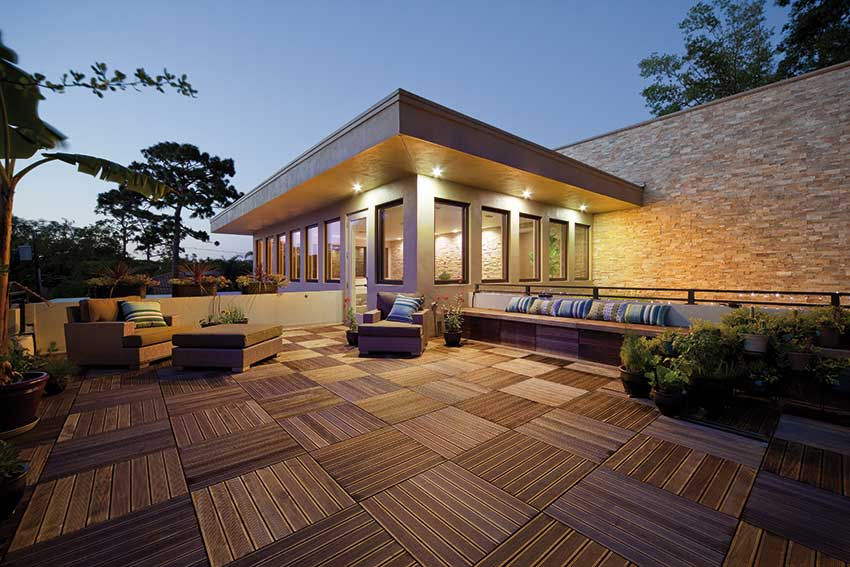
Photo courtesy of Bison Innovative Products
The ribbed ipê wood tiles are modular and allow for unique design layouts. The parquet pattern utilized in this home’s gorgeous rooftop deck give the wood tiles a varying, versus uniform, appearance. The ribbed surface not only adds an element of texture to the design, it also ensures the deck is slip resistant and remains scuff free.
Circular Materials In Innovative Exterior Products
A significant amount of all materials ever extracted in human history are locked within the built environment11 suggesting that buildings will become a major material stock to supply future demand. Under the linear economic model, continued inefficient use of non-renewable materials will almost certainly cause significant natural-resource depletion. In contrast, the adoption of CE principle in the construction industry promotes the use of sustainable materials, maximizes material recovery, and avoids unnecessary waste generation and waste disposed to landfills.12
When thinking about decks and outdoor living and entertaining, sustainable products are not the first thing called to mind. However, leading manufacturers are making advances in waste capture to bring more closed loop products to market. FSC®-certified wood, used in outdoor decking, comes from forests certified by the Forest Stewardship Council® to meet high global standards for forest sustainability. FSC® certification assures wood products have positive environmental attributes and are backed by a global system of verification. Certain manufacturers are taking outdoor deck materials one step further, engineering planks and tiles from remnants or shorts from other milling operations. {{question1}}
{{question2}}
{{question3}}
{{question4}}
These innovative modular and versatile deck systems provide architects the design flexibility to create unique and beautiful rooftop environments and outdoor spaces. Architects can include a mix of pavers and surface materials including wood, stone, structural porcelain, crushed rock, grating, artificial turf, and concrete, and planter cubes and benches, to create unique, custom looks that allow for a maximum diversity of material use. Versatile, adjustable pedestal deck systems can be created over any structural surface, including bare structural decks, rooftop decks, roof membranes, green roofs, terraces, compacted grade, pavement, pool surrounds, or water features. This flexibility allows capture of unused space in the city, or for upgrades to a porch or backyard in the suburbs, creating a low- or zero-waste renovating solution for a variety of applications while creating valuable outdoor space.
Made from recycled content and fully recyclable at their end of life, sustainable decking products are manufactured in an environmentally sensitive and efficient manner. These systems can help to achieve prerequisites and accumulate points in the following categories of LEED, including under Materials and Resources Credit 4, 6, and 7, in Material Content with Recycled Content, and contributions to LEED | SITES points.
Outdoor decks connect residents to the natural environment through the use of natural materials, such as wood and stone, and incorporate vegetation and greenery into an individual’s regular routine through the use of planter cubes and pots. Regular interactions with the outdoors are proven to lower blood pressure, reduce stress, expedite healing, and improve a person’s mood and focus.
Opening The Door To Circularity: Viewing Doors As Reusable Materials
Results show that, in most cases, the reuse and recycling of construction and demolition waste at the end-of-life of a building, as well as the production of recycled products, provide environmental and economic benefits.13 The concept of CE promises an alternative to the current linear economy of "take-make-use-dispose." In CE resource use, waste, and emissions are minimized by narrowing (efficient resource use), slowing (temporally extended use), and closing (cycling) material loops.14
Single-family homes can be significant contributors to a circular economy by utilizing an ever-expanding array of opportunities through materials and products. One often overlooked avenue is to employ recyclable or reusable glass and glazing systems. Expansive views are a sought-after feature in modern residential housing developments. This has given rise to incorporating large-scale, movable wall systems such as sliding and bi-folding doors that can reach heights of 12 feet or more. What makes these systems sustainable, as well as stylish, are their materials. Certain sliding and bi-fold doors are primarily built from demountable aluminum extrusions which can be deconstructed and recycled. The glass panels can also be recycled.
Glass is 100% recyclable and can be recycled endlessly without loss in quality or purity, according to the Glass Packaging Institute. Glass is made from readily available domestic materials, such as sand, soda ash, limestone, and “cullet,” the industry term for furnace-ready recycled glass. The only material used in greater volumes than the cullet is sand. These materials are mixed, or “batched,” heated to a temperature of 2600 to 2800 degrees Fahrenheit, and molded into the desired shape.
Recycled glass can be substituted for up to 95% of raw materials. The Glass Packaging Institute outlines a number of benefits from using recycled glass: recycled glass is always part of the recipe for glass, and the more that is used, the greater the decrease in energy used in the furnace. Energy costs drop about 2-3% for every 10% cullet used in the manufacturing process. One ton of carbon dioxide is reduced for every six tons of recycled container glass used in the manufacturing process. Over a ton of natural resources are saved for every ton of glass recycled.
Leading door and glass manufacturers are offering sliding door and bi-folding door series that create innovative solutions to enhancing sustainability, energy efficiency, and occupant welfare in contemporary single-family housing. Because of their minimal frames, these door systems allow for ample daylight to enter the interior space, so that the use of artificial lighting is reduced, thus further lowering energy consumption. Slim, minimal frames maximize views and, when opened, provide seamless transitions to the exterior. These benefits combined serve to improve the health and welfare of occupants.
The most innovative sliding and bi-folding doors are demountable systems, which allows for the recycling of aluminum extrusions. These demountable products feature distinctly slim frames and panels that produce the expansive views that occupants look for. At the same time, they offer exceptional thermal performance by using thermally broken frames and 1-inch insulating glass units which, together, can produce U-factors as low as 0.36. This effectively reduces dependency on air conditioning systems, improving the energy efficiency of single-family homes. To maintain a target on sustainable design, when architects specify demountable movable wall systems, whether sliding or bi-folding doors, specifying thermally broken frames and 1” insulating glass effectively mitigates heat transfer. Reducing heat transfer helps to keep interior temperatures cool during the summer and warm during the winter. This places less strain on HVAC systems throughout the year, which reduces energy consumption, and enhances comfort for occupants.
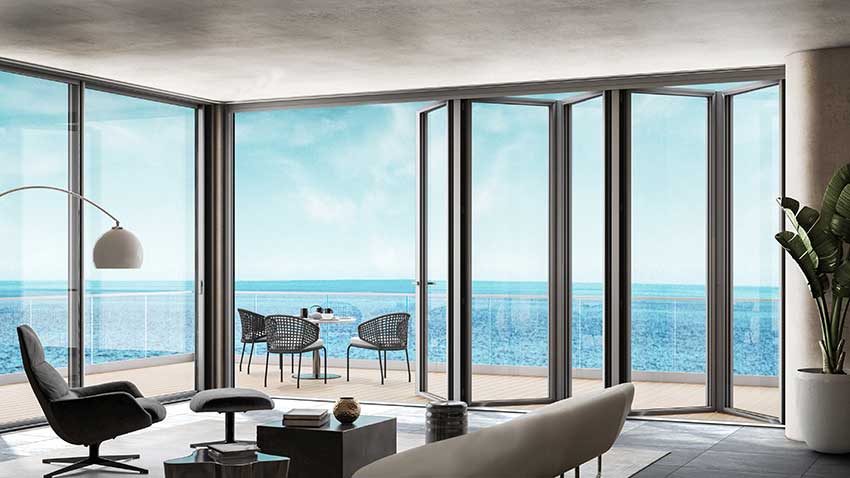
Photo courtesy of CRL
The glass and aluminum in movable wall systems offer an exceptional example of closed loop materials.
Using A CE Approach For Certification
In both the United States and Europe, the driving focus of sustainability and energy programs has been to reduce operational energy consumption of buildings in order to minimize the environmental impacts they induce. However, as buildings are becoming more energy efficient, the embodied environmental impacts stemming from production, construction, maintenance, and disposal of building materials represent an increasing share of a building’s total environmental burden.15 Embracing CE as an approach to materials, therefore, becomes an important step towards continuing efforts to reduce buildings’ environmental burdens.
Construction should not be seen as an environmental evil. Construction and buildings play an important positive role in society and the economy. The construction sector is a key area that has significant impacts on the economy and environment.16 Construction contributes to the economy, creates millions of direct and indirect job opportunities, and satisfies the need for buildings and facilities. According to the U.S. Bureau of Economic Analysis, GDP from construction in the U.S. was $649.10 Billion in the fourth quarter of 2021.
CE does not spell the end of building and design. Rather, by applying CE to the construction supply chain, the focus turns on the integration of environmental considerations, including material flow reduction and the minimization of inadvertent negative consequences of the production and consumption processes . According to S. Balasubramanian, creating green supply chain management in construction is based on three dimensions: environmental, economic, and operational performance.
Addressing the processes involved in construction from an operational perspective, green supply chain management includes “green purchasing, green manufacturing, green distribution (marketing) and reverse logistics.” Smart material and product selection play a key role in the homes of the future.
CE and LEED
Building performance rating and certification programs are also increasingly turning their attention to addressing the diverse, alternative ways that buildings can benefit the environment, beyond simply reducing energy usage.
The U.S. Green Building Council’s (USGBC) Leadership in Energy and Environmental Design (LEED) rating system offers Circular Products credit. Under LEED v4.1, project teams are rewarded for selecting products that support the CE. This includes products that are manufactured with zero waste, are designed to be cycled multiple times through repair or remanufacturing, or products that are recovered at the end of their useful life to be remade into new products.
To earn a Circular Products credit, the project must use at least five permanently installed products from three manufacturers that demonstrate achievement of at least one of the circular product reports: Supply Chain Circularity, Zero Waste Manufacturing, Designed for Circularity, or Closed Loop Products. No more than four products can come from one category of criteria below. {{question5}}
{{question6}}
{{question7}}
LEED v4.1 Requirements
Supply Chain Circularity
Recycled Content Disclosure: For products that include recycled content (pre- or post-consumer), the manufacturer has published additional details about the former source(s) of the recycled content:
- Disclose the amount of recycled content, pre- and post-consumer. For the credit purposes, pre-consumer materials must originate from sources other than the final product manufacturer, such as materials traded between companies or industries.
- Disclose what specific product the recycled material(s) were used in last. If they were sourced from more than one product, include percentages from each product type. Estimates, industry averages, or ranges are not acceptable.
- Disclose the location (country, state, or province) that the waste products were collected from.
- Disclose the location of the facility (country, state, or province) where waste was processed or converted into usable recyclable material or feedstock.
- Valuation: Products with less than 10% recycled content: value at ½ product. Products with 10% or more recycled content: value at 1 product.
- Safe & Circular: Manufacturers of products that contain specific types of recycled content shall provide a lab analysis of the recycled content that tests for common contaminants. The specific types of recycled content materials are glass cullet, wood fiber, plastics, polymers, asphalt, metals (aluminum, copper and steel) and ground rubber.
- Disclosure: Products with report that discloses the content levels of common contaminants, value at 1 product.
- Optimization: Products with a lab analysis of the recycled content that tests and shows acceptable levels of the common contaminants are present in the final product. Acceptable levels are below detectable levels or below the levels required for the same product made of virgin materials. Value at 1.5 product.
Zero Waste Manufacturing
Select products manufactured in a facility that reduces waste throughout the manufacturing process and is third party verified to divert 90% or more of all waste from landfill and incineration. Value at 1 product. Acceptable certifications are:
- GreenCircle Zero Waste to Landfill
- NSF Landfill-Free verification
- TRUE Certification (any certification level)
- UL 2799
Designed for Circularity
Select products that have been designed for disassembly, repair, or reuse at the end of use and for which the manufacturer has provided detailed information on maintenance, reuse, disassembly, and recovery options. Specifically, the product must be designed to be easy to separate, without destruction of components, and all necessary instructions for maintenance in-use and cycling at end of use are indicated or attached to the product or otherwise available to subsequent owners of the building. The following reports and certifications can be used to meet these requirements if they include all relevant information:
- Valuation: Compliant reports are valued at 1 product.
- Manufacturer has published a public type III EPD that includes an analysis of the life-cycle impacts from cradle to grave, including the recovery and disposal phases. The report must include LCA Stages for end-of-life modules and any relevant benefits or loads beyond the system boundaries. The product must also have publicly available instructions for how to take back, reuse, disassemble, or recover materials at end of use.
- The product has achieved Cradle to Cradle v3 Gold certification in the Materials Reutilization category and has published a nutrient management strategy that includes instructions for how to disassemble, reuse, or recover materials at end of use.
Closed Loop Products
Verified closed loop product: Products have been third party verified for recovering and recycling materials at the end of useful life. The manufacturer has an established process and system to take back their products for reuse and recycling into the same or similar products within the manufacturing operation.
- Certified Closed Loop, GreenCircle, value at 1.5 product.
- The product has achieved Cradle to Cradle v3 Platinum certification in the Materials Reutilization category and has published a nutrient management strategy that includes active nutrient cycling. Value at 1.5 product. Products-as-a-service: Select permanently installed products that are contracted through a products-as-a-service model and include take-back and cycling of the product at the end of use.
- Value at 1 product for every service contracted as a product-as-a-service agreement with a manufacturer.
- Refurbished or remanufactured products: Select permanently installed products that are refurbished or remanufactured. Qualifying products must be purchased directly from a manufacturer or refurbisher. Value at 1 product.
Additional attributes of product circularity are captured in other credits in LEED, such as recycled content percentage, Extended Producer Responsibility programs, construction waste reduction, and building materials salvage and reuse.
These are the advantages of the Circular Economy in principle. How are today’s innovative products embracing CE in practice?
MOVABLE WALLS ENHANCE DAYLIGHT, VENTILATION, AND ARE EASILY REPURPOSED
New innovations in movable wall installations allow for sophisticated design that makes a visual statement, using remarkable simplicity. Ultra-slim 1-5/16” panel rails and stiles create a minimal and uniform frame that produces uninterrupted views, while letting daylight flow freely to enliven interiors. With a maximum panel height of 13 feet and width of 7 feet, these sliding doors delivers expansive scale and elegance. Assemblies with a Performance Grade rating are ideal for exterior applications where high loads, limits on deflection, and heavy use are expected.
Despite the size of large sliding panels, advancements in sliding door construction provide effortless, one-handed operation. With a maximum panel weight of 700 pounds, panel loads are evenly distributed across the bottom rolling components resulting in a fluid, frictionless glide. The precision-engineered stainless-steel track further facilitates panel movement. Doors can offer a standard U-factor of 0.38 with a thermally broken frame using 1” insulating glass, CW40 Performance Grade rating, and 33 STC rating. Door hardware features a multipoint locking mechanism and integrated stainless-steel flat handle.
Bi-Folding doors have also attained the next generation in features and performance. A distinctly slim 4-3/4 inch vertical sightline and 1-7/16 inch panel rails reduce visible hardware to produce a minimal aesthetic that maximizes views. A bottom rolling system eliminates strain on the overhead beam. When closed, door hinges are completely concealed to deliver an elegant and streamlined look. Leading manufacturers provide superior thermal and structural performance using a 3-1/2-inch system depth. Doors distinguished with a CW40 Performance Grade rating make the ideal system for exterior applications where larger sizes, higher loading requirements, limits on deflection, and heavy use are expected. With a thermally broken frame and 1-inch insulating glass, bi-fold door assemblies have a standard U-factor of 0.36 and 32 STC rating.

Photo courtesy of CRL
Manufacturers have enhanced the design of bi-fold and sliding door construction to provide superior thermal and structural performance.
Bringing the Outside In
Sliding and bi-folding movable walls that feature slim, minimal frames maximize views and allow ample daylight to flow in. When opened, they also provide seamless transitions to the exterior. These benefits combined serve to improve the health and welfare of occupants.
Modern sliding door and bi-folding doors represent two innovative solutions to enhancing sustainability, energy efficiency, and occupant welfare in contemporary single-family housing. They are demount- able systems, which allows for recycling of aluminum extrusions, besides incorporat- ing recycled glass. They feature distinctly slim frames and panels that produce the expansive views that occupants look for. At the same time, they offer exceptional thermal performance using thermally broken frames and 1-inch insulating glass units that together can produce U-factors as low as 0.36. This effectively reduces dependency on air conditioning systems, improving the energy efficiency of single-family homes. {{question8}}
MODULAR, RECYCLED MATERIALS THAT CREATE VALUABLE OUTDOOR SPACE
Using deck and exterior products that have a modular design for surface materials and accessories allows designers to fulfil an abundance of different design visions without the need for custom or costly materials. Harnessing the power of recycled and certified materials, modular decks bring additional advantages to the table. Offering tremendous design flexibility, coupled with ease of installation, adjustable pedestal deck systems provide a unique and viable alternative to traditional deck building materials and methods. Pedestal decks can be used in a variety of spaces- balconies, rooftops, and/or on-grade applications. Modular decks installed with a pedestal system provide the opportunity to turn underutilized or wasted outdoor spaces into a functional amenity, extending indoor living space or generating an outdoor oasis of its own.
Modular deck systems offer quick and easy installation. Fastening kits facilitate secure installations of wood tiles and paver-tray-backed pavers without harm to the tiles or pavers. Built-in bottom slope-leveling mechanisms provide pedestal stability and adjustability, even once loaded. Tab sets on each pedestal allow for consistent tile or paver spacing.
Circular Materials Durable Enough for the Exterior
Leading manufacturers have created wood deck tiles that are commercial grade and available in standard and FSC® Certified options. Wood tiles are crafted from premium grade remnants and material harvested in an environmentally responsible method, and are designed to preserve the economic viability of rainforest hardwoods. Wood species include fused bamboo, cumaru, garapa, ipê, itauba, and tigerwood. Tropical hardwoods contain a rich variety of graining and coloration, are exceptionally dense, and resistant to insects. These commercial-grade, high-density wood species weather well, allowing for minimal maintenance. If maintaining the wood color is desired, wood tiles can be periodically cleaned and sealed. Left to weather naturally, the wood tiles will develop a silvery-gray patina. Weighing one third as much as concrete tiles, wood tiles are a good alternative when surface material weight is a factor.
When combined with pedestals, wood tiles offer one of the most labor- and cost-efficient methods of creating a flat, level deck over a sloped sub-surface. Manufacturers today offer domestically made pedestals constructed out of high-density polypropylene plastic, comprised of 20% post-industrial recycled content, that are also 100% recyclable. Pedestal deck support systems are impervious to water, mold, and freeze-thaw cycles. Using a gravity system, the supports protect roofing membranes and waterproofing and do not damage or harm the surface below. Pedestal systems can support decks over occupied space, allowing cavity space for electrical systems, duct work, and irrigation. Deck supports are designed to elevate a variety of substrates, including granite or concrete pavers, wood tiles, composite materials, fiberglass grating, or conventional wood decking systems.
Modular decking naturally accommodates site furnishing, including planters and seating or storage. These modular units are designed to integrate perfectly with modular pavers in a pedestal deck system, making it easy to design a custom, beautiful outdoor environment. Modular cubes can host plant life in the summer and be repurposed for seating and storage in the winter. Lightweight, durable powder-coated aluminum modular trays expand the design options for rooftop environments. Used as a containment system for architectural rocks or other deck elements, low clearance trays work with the modular pedestal system to add dimension and texture to deck areas. Incorporating a pedestal system can provide pedestrian access to green roofs.
Besides recycled and recyclable content, modular pedestal decks provide passive solar heating and cooling. Pedestal deck systems can help reduce cooling loads of the building structure because they are air permeable. {{question9}}
RENEWABLE ENERGY THAT REDUCES EMISSIONS AND PROVIDES RESILIENCE
Using propane as a fuel or energy source means harnessing an available clean technology to reduce emissions while still meeting energy needs. Propane is clean and nontoxic. Propane is abundantly available, and the growth of renewable propane means it can be used for generations to come.
Both high-efficiency propane furnaces and propane tankless water heaters can be key components in earning the LEED for Homes (LEED H v4) and the 2015 National Green Building Standard (NGBS) certifications for a home. High-efficiency propane furnaces and water heaters can reduce a home’s HERS Index by anywhere from 9 to 14 points.
Onsite Energy, Ready for Resilient Homes
Power outages are becoming a more frequent fact of life. The average homeowner will experience 3.5 power interruptions in a two-year period. According to Eaton’s 2014 Blackout Tracker Annual Report, the United States suffered 3,634 power outages in 2014, affecting more than 14 million people. That’s 12 percent higher than 2013, and 285 percent more often than in 1984. Between 2008 and 2017, California endured 4,297 power cuts – more than double the number of next runner-up Texas, which experienced 1,603. New York came in third with 1,528 outages, followed by Michigan (1,369), Ohio (1,349) and Pennsylvania (1,256)20. What’s more, according to the U.S. Department of Energy, outages are also lasting longer. Despite the financial and emotional toll a power outage can place on a family, with even short outages lasting less than four hours costing homeowners an average of $1,250, only 27 percent of homeowners report having any source of backup power.
In areas where natural disasters occur, many builders have discovered the value of marketing more durable homes. This is certainly true for net zero or off-grid homes that may utilize multiple forms of power, including solar and wind. Propane standby generators offer a powerful, reliable way to protect homes and families, as well as buildings and businesses, from the damage a power outage can cause.
A standby generator powered by propane offers definite advantages over other fuel source generators. Propane doesn’t degrade over time, unlike diesel or gasoline, making it an ideal standby power fuel. Propane produces significantly fewer greenhouse gas emissions than diesel or gasoline and is non-toxic, non-poisonous, and won’t contaminate soil or water. Propane can handle an entire home’s energy needs for days, unlike solar- or wind-powered systems. Permanently installed and supplied by an above- or below-ground tank, a propane system starts automatically, the moment the power goes down, supplying supplemental electricity in as little as 10 seconds after an outage.
A propane standby generator provides homeowners heating and cooling, lighting, refrigeration, and the amenities their neighbors are without, after the power is knocked out. A reliable propane standby generator can be a key part of resilient, self-contained energy design, which allows a house to continue providing the primary function of a home after a disaster. On-site generators allow a home to resist hazards brought on by major disasters, such as damage to appliances or electronics, spoiled food, loss of heat or air conditioning, hotel costs, and more. Resilience through on-site power reduces the magnitude or duration of a disruptive event to a property and the impact on homeowners.

Photo courtesy of PERC
Resilience through on-site power reduces the magnitude or duration of a disruptive event to a property and the impact on homeowners. A propane standby generator provides homeowners heating and cooling, lighting, refrigeration, hot water, and other amenities their neighbors are without, after the power is knocked out.
HAVING IT ALL
Embracing circular economic principles as a residential design professional and a homeowner does not mean adopting a more restricted lifestyle. Rather, it offers every advantage one might want: from architectural flair, to safety and reliability, to a lifestyle that enhances physical and mental health and wellness. It also protects the environment by reducing the strain on resource availability through the efficiency and effectiveness of resource use and by reducing waste. It is truly a burgeoning way to have it all.
{{question10}}
END NOTES
1December 2014. The Benefits of Construction and Demolition Materials Recycling in the United States Prepared for The Construction & Demolition Recycling Association. Prepared by The Department of Environmental Engineering Sciences Engineering School of Sustainable Infrastructure and Environment University of Florida Timothy Townsend, Principal Investigator Christina Wilson, Student Assistant Blaine Beck, Student Assistant Version 1.1 (updated January 14, 2015) June 7, 2022
2Gabriel Luiz Fritz Benachio, Maria do Carmo Duarte Freitas, Sergio Fernando Tavares, Circular economy in the construction industry: A systematic literature review, Journal of Cleaner Production, Volume 260, 2020, 121046, ISSN 0959-6526
3Ibid.
4Patrizia Ghisellini, Maddalena Ripa, Sergio Ulgiati, Exploring environmental and economic costs and benefits of a circular economy approach to the construction and demolition sector. A literature review, Journal of Cleaner Production, Volume 178, 2018, Pages 618-643, ISSN 0959-6526,
5Ibid.
6Masoud Norouzi, Marta Chàfer, Luisa F. Cabeza, Laureano Jiménez, Dieter Boer, Circular economy in the building and construction sector: A scientific evolution analysis, Journal of Building Engineering, Volume 44, 2021, 102704, ISSN 2352-7102
7Ibid.
8(2020) IIEA - Methane Tracker 2020.
9(2021) EPA - CHP Benefit.
10(2021) Renewable Propane as a Sustainable Fuel Solution in California.
11Building design and construction strategies for a circular economy. Leonora Charlotte Malabi Eberhardt, Morten Birkved & Harpa Birgisdottir P Architectural Engineering and Design Management, Volume 18 Issue 2 Pages 93-113 | Received 15 Aug 2019, Accepted 09 Jun 2020, Published online: 23 Jun 2020.
12Masoud Norouzi, Marta Chàfer, Luisa F. Cabeza, Laureano Jiménez, Dieter Boer, Circular economy in the building and construction sector: A scientific evolution analysis, Journal of Building Engineering, Volume 44, 2021, 102704, ISSN 2352-7102.
13Patrizia Ghisellini, Maddalena Ripa, Sergio Ulgiati, Exploring environmental and economic costs and benefits of a circular economy approach to the construction and demolition sector. A literature review, Journal of Cleaner Production, Volume 178, 2018, Pages 618-643, ISSN 0959-6526.
14Building design and construction strategies for a circular economy. Leonora Charlotte Malabi Eberhardt, Morten Birkved & Harpa Birgisdottir P Architectural Engineering and Design Management, Volume 18 Issue 2 Pages 93-113 | Received 15 Aug 2019, Accepted 09 Jun 2020, Published online: 23 Jun 2020.
15Ibid.
16Masoud Norouzi, Marta Chàfer, Luisa F. Cabeza, Laureano Jiménez, Dieter Boer, Circular economy in the building and construction sector: A scientific evolution analysis , Journal of Building Engineering, Volume 44, 2021, 102704, ISSN 2352-7102.
17Ibid.
18S. Balasubramanian. A structural analysis of green supply chain management enablers in the UAE construction sector Int. J. Logist. Syst. Manag. (2014), 10.1504/IJLSM.2014.064655
19S. Badi, N. Murtagh. Green supply chain management in construction: a systematic literature review and future research agenda J. Clean. Prod. (2019), 10.1016/j.jclepro.2019.03.132
20Eaton Blackout Tracker United States Annual Report 2018.Amanda Voss, MPP, is an author, editor, and policy analyst. Writing for multiple publications, she has also served as the managing editor for Energy Design Update.

